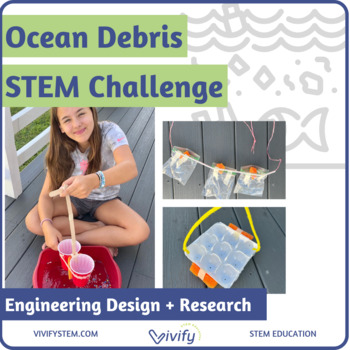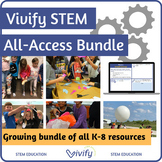Ocean Debris Engineering Design STEM Challenge
- PDF
What educators are saying
Also included in
- Are you in need of year-round STEM activities? This growing bundle includes our most popular STEM lessons and engineering design challenges for elementary! Activities are adaptable for 1st through 5th grade with guidance provided in the teacher notes. Need help with a STEM Curriculum Map? Grab our FPrice $410.72Original Price $513.40Save $102.68
- Save 20% off individual products with this all-inclusive ocean study STEM unit! Students will explore science concepts through engaging scientific inquiry and apply an engineering mindset to two design challenges, culminating with a final project on researching and building an ocean animal observatoPrice $19.40Original Price $24.25Save $4.85
- Are you in need of year-round STEM activities? This growing bundle includes ALL Vivify K-12 STEM lessons from team challenges, engineering design, semester-long STEM units, research projects, and more! Purchase everything for 20% off individual products! Here is a sample of what is included: Stage 1Price $990.24Original Price $1237.80Save $247.56
Description
Ocean Debris Engineering Design STEM Challenge
After learning about ocean pollution, students use the engineering design process to build an ocean debris cleaner that has buoyancy and can pick up microplastics.
Lesson Sequence:
- Relay Recycle Bin Sort: Students will be given a garbage bag of mixed recycling items - paper, glass, plastic, and metal. Students will have to relay back and forth separating/grouping the like items one item at a time without talking to their relay partners!
- Learn about the Great Pacific Garbage Patch, Ocean Engineering, and Mr. Trash Wheel.
- Complete Ocean Debris Engineering Challenge.
- Research and report on a current ocean debris cleaner.
Real-world STEM Connection:
- Ocean Engineering
- Marine Engineering
- The Great Pacific Garbage Patch
- Mr. Trash Wheel clean-up innovation
As with many STEM activities, this challenge can be tailored to students of various skill levels and abilities.
Included in this product:
- Detailed teachers guide with links to resources
- Editable teacher companion presentation slides
- Photos and videos of student examples
- Editable printed & digital student handouts to guide them through the design process
- Videos to motivate and support learning
- Editable Google Slides STEM journal for distance learning
- STEM Career Connections and real-world examples
- Student recording sheet for each step of the process
Suggested Materials: Many different materials can be used for this challenge. Here are some suggestions that worked well for our students.
- Sponges, loosely woven cloth, mesh fabric
- Pool noodles, bubble wrap, pieces of foam, foam egg cartons, balloons
- Pipe cleaners, small plastic pipes, popsicle sticks, strong straws
- Plastic cups of various sizes
- Ziploc bags - small & large
- Scissors, hole puncher
- An ice pick
- String or rope
- Duct tape and masking tape
- Hot glue gun with glue sticks
Testing materials:
- Large tub of water or a small baby pool
- Ocean debris like plastic bags, bottle caps, straws, cups
- Perler beads to represent microplastics
Looking for more STEM lessons? Our team of engineers and educators is dedicated to developing low-prep and high-quality STEM activities for any classroom! Click below to learn more:
- Vivify's Scope & Sequence + Standards Alignment
- Vivify's Resource Guide
- Learn about the 3 Stages of STEM
- Vivify STEM Membership
Customer Tips:
• Click the Green ★ to follow our store and get notifications of new products and freebies
• Leave feedback to receive TpT credit for use on future purchases
• Questions? Contact us in the Product Q&A section
♥ Connect With Us ♥
Email us: info@vivifystem.com








